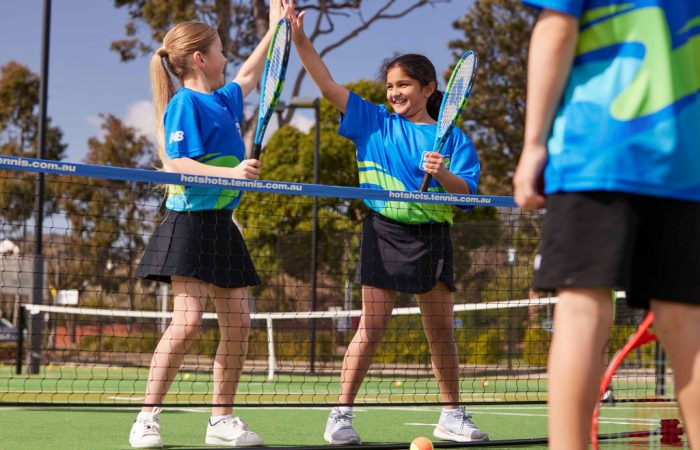Hot Shots Tennis provides a perfect start
The Hot Shots Tennis program not only provides kids with fun first steps in the sport but also builds skills that support them for life.
Australia, 12 December 2023 | Tennis Australia

Courts divided up and filled with young kids scampering for multi-coloured balls is a positive sign for coaches Shayne Tabb and Helen Magill that the future of tennis is bright.
Tabb, a player development coach with Tennis Plus on the Gold Coast, believes fun and engagement are keys to keeping those young players involved, and the Hot Shots Tennis program is a first formative step in helping ensure those who take up the sport stick with it.
“The court size, the modified balls, the modified courts, it’s appropriate for the age and the size of the children, so by having lower-compression balls, and smaller courts, a smaller net, it allows the children to fulfil some competencies that maybe they wouldn’t fulfil on a bigger court,” Tabb says of Hot Shots.
“We’re not just upskilling, we’re talking about a sport that is an investment – something you can play most of your life, unlike other sports like football.”
Hot Shots allows for up to four mini courts on a court all the way up to full-size tennis courts as the kids progress.
Both coaches agree it is the ideal way for kids to develop their skills all the way from ages three to 10+.
Magill, a club pro coach, developer and mentor at Tennis Australia, sees the organisation’s “Play to Learn” slogan as a theory which gives players more opportunities to build confidence and competence in their early tennis journeys.
“The philosophy encourages every player to explore and problem solve through purposeful practice facilitated by the coaching team,” Magill relates. “This gives them the autonomy to make their own decisions and be accountable for them even at an early age.
“The inquiry and questioning that can follow builds a deeper understanding of both the technical and tactical awareness by the player.”
Tabb explains that if done correctly the Hot Shots program builds a strong social connection.
“Football’s very easy when you’ve got big teams, but tennis is all very much individual or doubles, so if we can get a lot of kids on the court and a lot of courts on a court it does become quite tribal,” he notes.
“If you’re skilled enough in tennis, which the idea of Hot Shots is to be skilled quite early, there’s a better likelihood you’ll continue the game for other reasons, not necessarily competition, but for health and lifestyle.
“The health benefits, this is the No.1 isn’t it? If the fun’s not there though they won’t progress and play much longer.”
There are spin-off benefits, too, for mums and dads who became involved in the program for kids aged three to 10.
After the parents’ initial involvement on the court in the early stages of Hot Shots, it became more about watching their kids’ journey.
“We have parents who converse and have their group of four children ready to go as soon as the online registrations open each term,” Magill says.
“These relationships are built through school or social family groups and while the kids are enjoying their time on court, the mums, dads and carers are enjoying a weekly catch-up over coffee or a drink while watching their little ones on court.